
LIFECYCLE MANAGEMENT
Experience Studio: Visier’s In-App Interface To Control Change Management
The analytics tech ecosystem is always growing and evolving. This series guides technical stakeholders in organizations to understand how to uplevel their current ecosystem with Visier.
Start free trialTable of contents
What is Visier's Studio environment?Common data challenges the studio environment solvesSetting up users and permissionsHow to configure security settingsHow the studio environment helps you manage your dataHow to manage projects in the studio environmentHow new functionality is added to the platformEfficiently manage people analytics deliveryIn this post, we’ll explain the benefits of using Visier’s in-app interface, also called Studio, to run the entire lifecycle management process for Visier People®. Read on to learn more about the studio environment and how administrators can use it to efficiently manage people analytics delivery without downtime or disruptions.
What is Visier's Studio environment?
Visier's studio environment provides admins with the tools to customize the look and behavior of the solution. It provides a central spot to manage the Visier people analytics platform, which makes deployments and ongoing updates faster, easier, and safer. This is where you'll find options to manage data, create and configure content, and maintain security settings. Administrators can collaborate with other administrators to preview and publish changes to users.
![[VIDEO] Studio experience overview](https://images.ctfassets.net/lbgy40h4xfb7/2ffUoBoxt0jQzyZERoE56V/db7b413765c30995b784166467eaddcb/visier-studio-thumbnail.jpg?w=1200&h=700&fl=progressive&q=50&fm=jpg)
Studio provides a variety of tools for managing a people analytics function, including:
The ability to test and validate data and changes before pushing updates into production, reducing costs and risk with comprehensive lifecycle automation
Easy configuration of security settings
Role-based permissions
A streamlined process for importing and exporting data
Built-in project collaboration and approval workflows
A place where admins can manage content and customize analytic objects, including subjects (e.g. employees) and events (e.g. promotions) within Visier
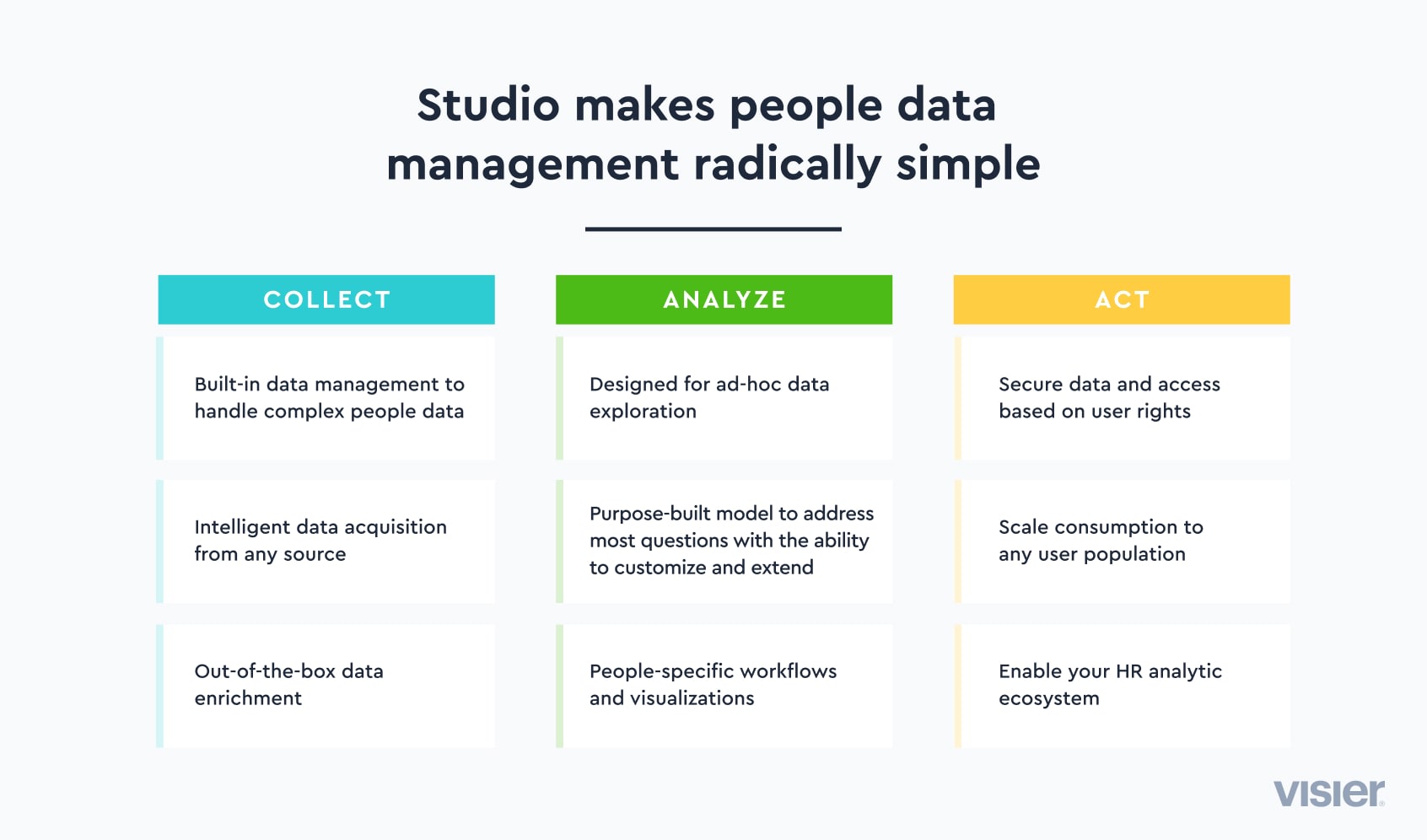
Common data challenges the studio environment solves
The most difficult part of standing up an analytics solution is typically sorting out your organization’s data issues. Studio helps admins overcome common people data challenges.
Challenge | How Visier Helps |
|---|---|
“I have disparate and messy data, without organizational controls to get the correct sequences of data to make things work” | Visier has an automated process to standardize and normalize data across sources and automatically maps all your HR and business data into our data model using our ETL (Extract, Transfer and Load) process to read the files. Visier automatically removes, replaces, and/or re-categorizes duplicate records or missing values, improving your overall data integrity. |
“Even if all of my data was ingested, the pre-built content won’t work for us as we have non-standard naming and we calculate metrics differently.” | With Visier, you have the power to fully customize how metrics need to be calculated and can create your own naming conventions, including setting definitions. One big advantage is that with Visier, organizational alignment on how things work is much faster as you have a central spot to bring your taxonomy together. There is guidance provided to make your calculations. |
“Compliance will crush any attempt to get the data into the right hands.” | Our multi-layered security model is pre-built and you can adjust it to suit your organization's needs. |
Studio allows admins to manage any changes with tools to stage and deploy updates to an organization’s Visier environment. These tools are designed to provide extensive customization options and reduce the risk of errors—admins can even roll back to a previous version if an unintended change is made. Admins can manage "the lifecycle" of initiatives without the usual back-and-forth changes and data syncing that happens when new information is added to source systems or during organizational restructuring. Studio is updated quarterly to provide organizations with access to new capabilities, insights, and ongoing innovations.
Our built-in tool helps technical teams:
Standardize and cleanse workforce data more efficiently
Rollout new people analytics functionality with ease
Create new workflows and collaborate on projects before releasing updates into production
Configure security settings
Customize data properties, metrics, concepts, or dimensions
Setting up users and permissions
For a successful analytics function, maximizing the impact of data without compromising its sensitivity is critical. Studio makes user management easy by enabling automatic provisioning using single sign-on (SSO) and supports multi-factor authentication (MFA). Users can also be added manually, through bulk uploads, and even managed using Visier’s User Management APIs. Once added, users can be dynamically assigned to groups containing the appropriate permissions.
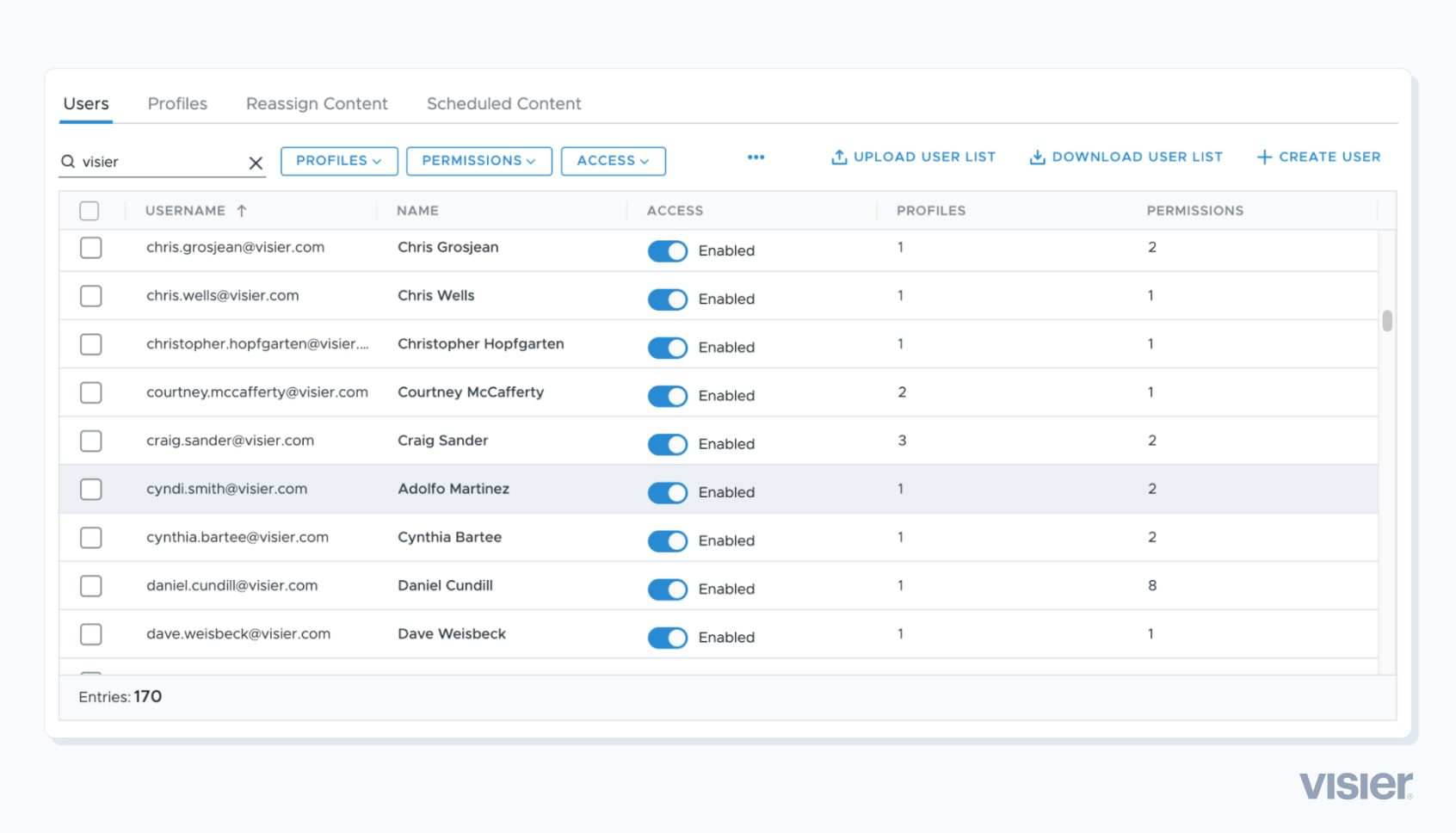
Shown above: The studio interface to set up new users
Role-based permissions allow admins to define user access to the data from certain populations, particular data attributes such as gender and ethnicity, content, and in-app capabilities. The security structure reduces the risk of oversharing data and significantly simplifies insights delivery.
Access to data and content can be controlled at a detailed or aggregate level. In addition, secure fields can be set to no access so that users can't see them. To mitigate risk even further, any permission changes can be tested within the draft projects before releasing updates into production.
How to configure security settings
Visier's platform security is based on isolating employee populations and supports SAML 2.0-compliant SSO for user authentication. Typically, users have different levels of access to the data of various populations. Within security settings, admins can configure access based on properties and attributes, or both, and preview changes before releasing them into production. Each subject (e.g. an employee or requisition) and event (e.g. promotion) can be secured regardless of the originating source system, including HRIS, Talent, and Acquisition systems. From the moment a user authenticates, the security models are applied consistently throughout the application.
Security rules can be defined to determine the components, data, and capabilities a user has access to, including whether they can view detailed information or are restricted at an aggregate level. The user’s profile determines where they can go and what they can do within the application. This robust security layer ensures users can only see what they should, which includes analyses shared by email. Admins can use our “View As” feature to test the security of a profile by impersonating the user.
Aggregate and detailed access
Here are two examples showing the difference between aggregate and detailed views.
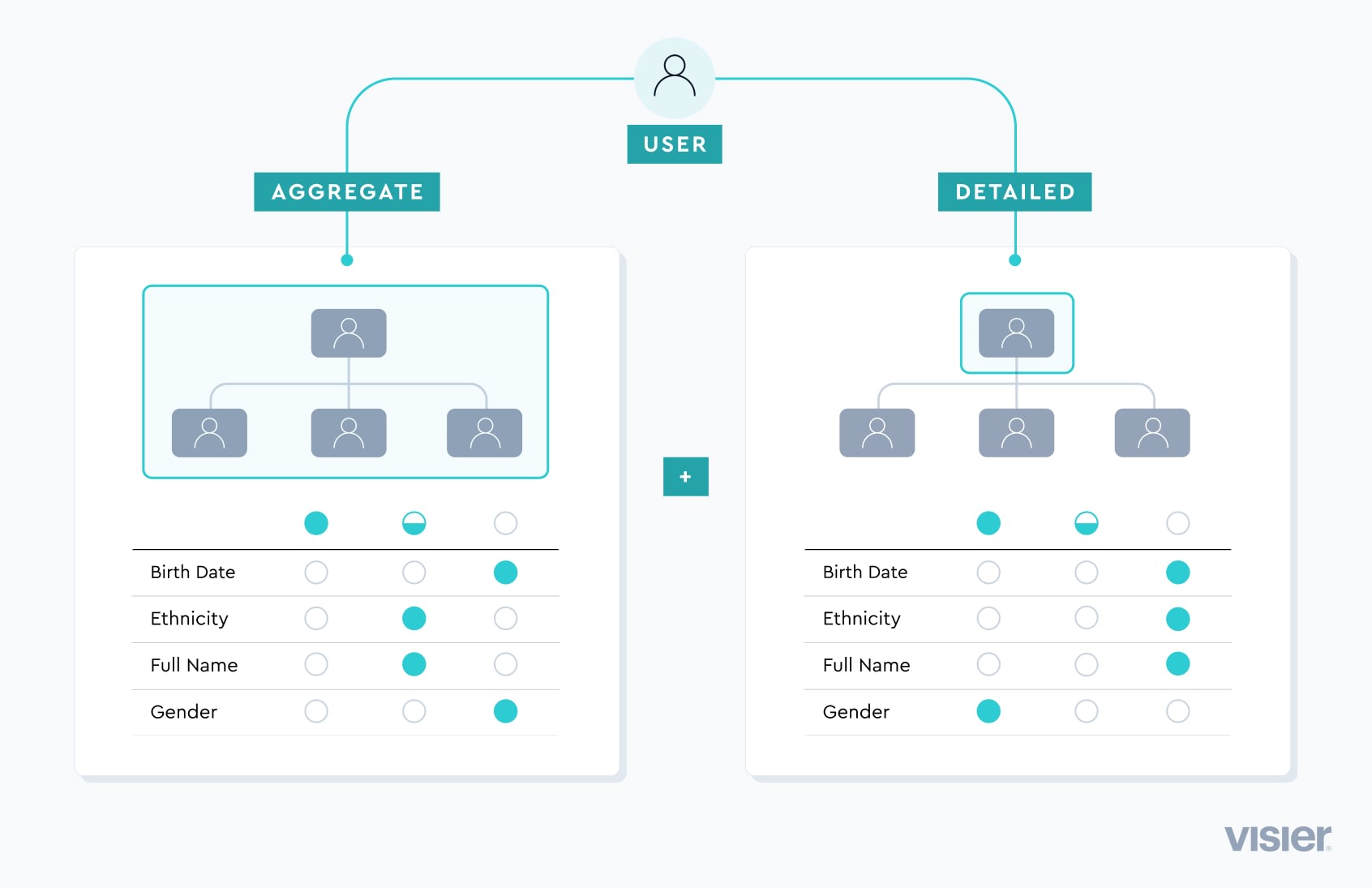
Shown above: Aggregate vs. detailed access control from a user’s perspective
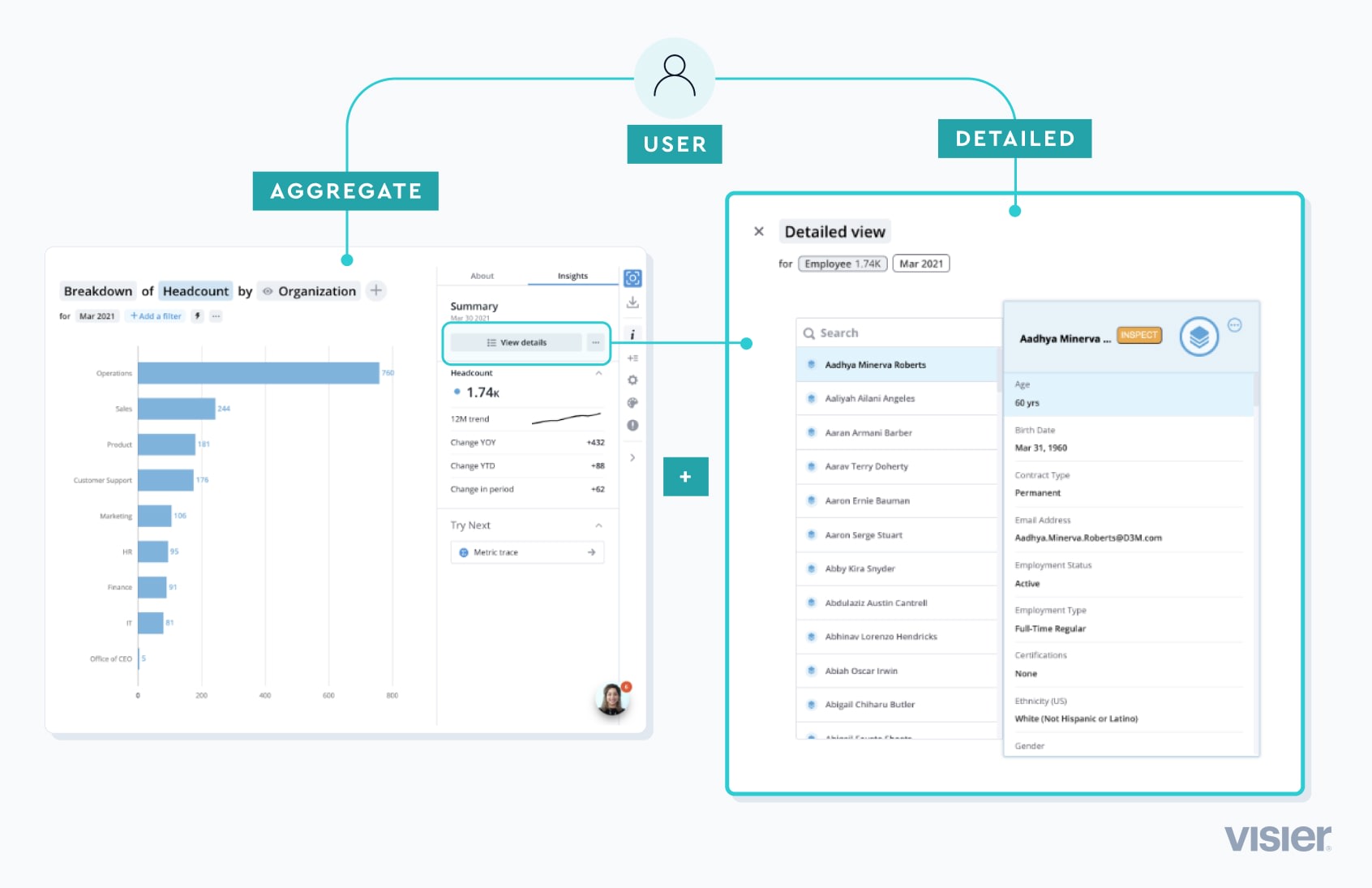
Shown above: A specific example showing how aggregate and detailed views differ in Visier.
Additionally, access levels can be set for each property individually, as shown below:

Security rules and control
Visier enables you to scale access to people analytics across your organization without requiring report writers, unlike standard BI tools like Tableau and PowerBI. Admins can import limitations or restrictions based on your organization’s unique data security requirements, such as prohibiting users from exporting analyses and the associated details. Admins have full control of security rules, allowing them to create as many as necessary to meet your organization's functional requirements and ensure proper data segregation.

Visier's security layer controls what manager's can view.
Data security reports include a summary of the populations and properties a user has access to.

Shown above: Sample data security report
How the studio environment helps you manage your data
Traditional data schemas struggle to handle the dynamic nature of people data. Visier’s event-based analytic model is built to support complex people data and manage the constant flux of organizational changes. Our data processing engine can handle the unique time-based attributes and the evolving nature of the employee’s journey.
You don’t need to have perfectly clean data to start using our people analytics platform. Once your data is in Visier, we provide a Data Validation guidebook for admins to spot gaps across all datasets. If the source system can't be fixed, users can flag items needing attention using the "Flag and Fix" feature. Once issues are resolved, admins can retain fixes to prevent them from being overwritten. Our data mart continually manages evolving data corrections, automatically filling critical gaps. You can add new data whenever necessary.
How to manage projects in the studio environment
Visier makes managing a customer’s development lifecycle simple with projects. The list of changes in a project is tracked by the platform’s version control, enabling admins to determine what gets merged into production. Studio includes built-in approval workflows, editing, change status updates, and collaboration capabilities based on user permissions. Based on user privileges, any changes can be submitted for approval or released into production.
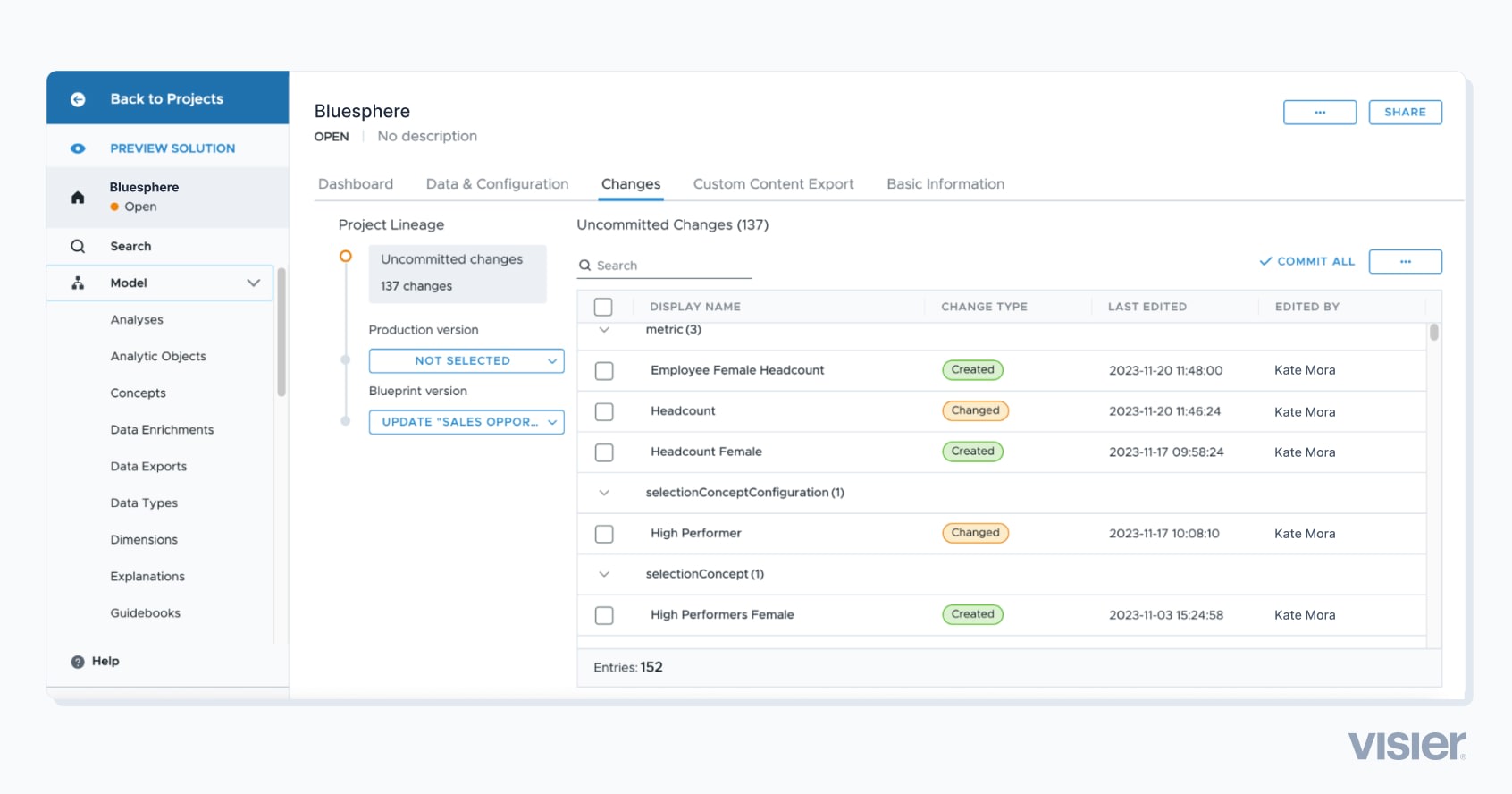
Shown above: An example of how changes can be managed in Studio.
How new functionality is added to the platform
Visier releases product updates and enhancements four times a year (Winter, Spring, Summer, and Fall) to all customers. Admins can use the preview environment within Studio to explore, test, and practice new features without impacting production environments. All admins are notified in advance of new releases and their software is automatically updated on the scheduled dates communicated. There's no customer action required to implement updates. Critical patches to fix bugs may be applied between releases if necessary. In these instances, admins are advised of the changes.
Efficiently manage people analytics delivery
Visier provides seamless lifecycle control to ensure organizations can build on top of their existing people data foundation and continuously make adjustments to reflect changing business requirements without impacting day-to-day people analytics delivery.
Want to see how easy it is to set up self-serve people analytics at your organization? Start a 30-day free trial of Visier People®, which comes with sample data and complimentary access to email and community support to help you get up and running—fast.


